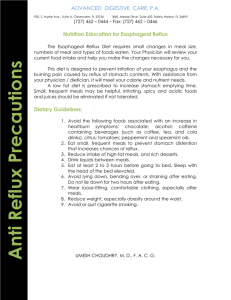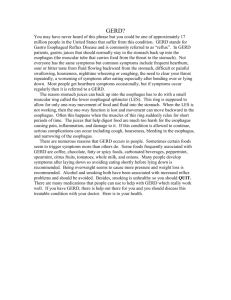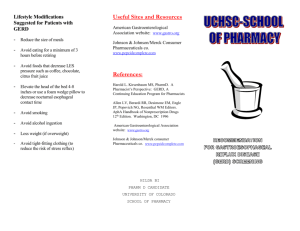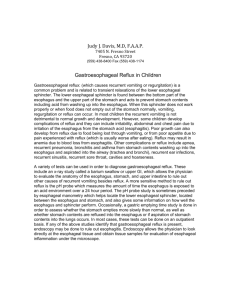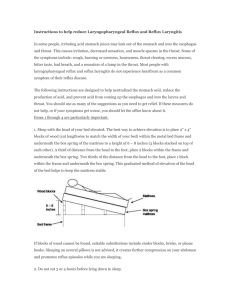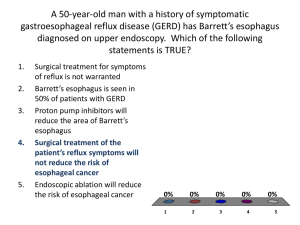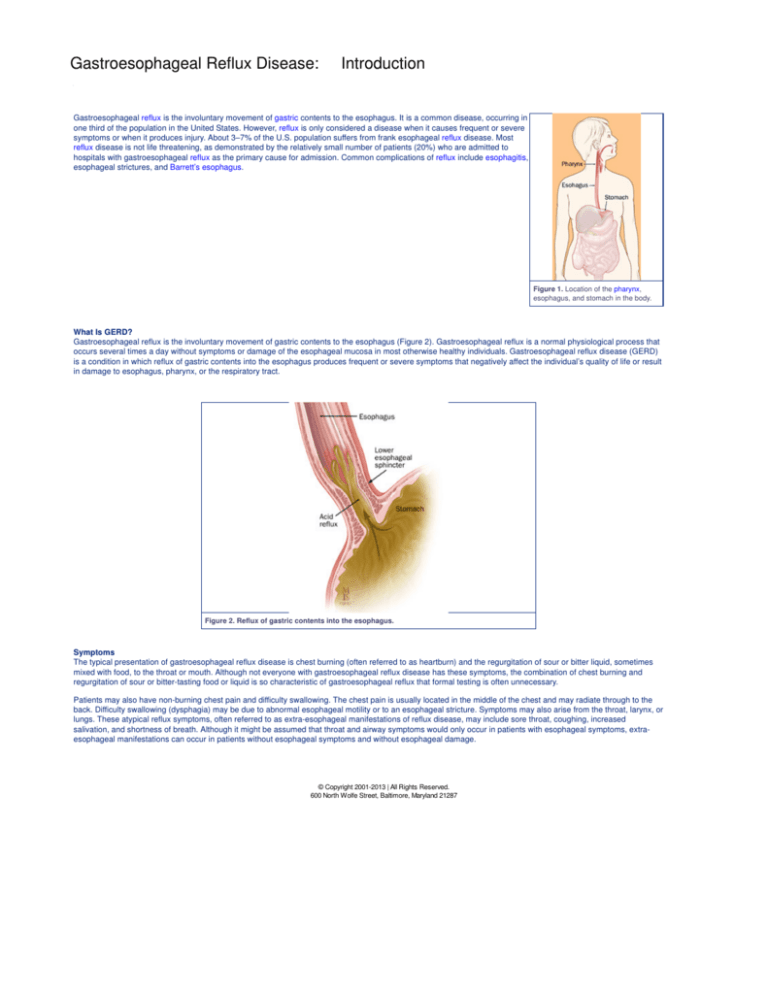
Gastroesophageal Reflux Disease:
Introduction
Gastroesophageal reflux is the involuntary movement of gastric contents to the esophagus. It is a common disease, occurring in
one third of the population in the United States. However, reflux is only considered a disease when it causes frequent or severe
symptoms or when it produces injury. About 3–7% of the U.S. population suffers from frank esophageal reflux disease. Most
reflux disease is not life threatening, as demonstrated by the relatively small number of patients (20%) who are admitted to
hospitals with gastroesophageal reflux as the primary cause for admission. Common complications of reflux include esophagitis,
esophageal strictures, and Barrett’s esophagus.
Figure 1. Location of the pharynx,
esophagus, and stomach in the body.
What Is GERD?
Gastroesophageal reflux is the involuntary movement of gastric contents to the esophagus (Figure 2). Gastroesophageal reflux is a normal physiological process that
occurs several times a day without symptoms or damage of the esophageal mucosa in most otherwise healthy individuals. Gastroesophageal reflux disease (GERD)
is a condition in which reflux of gastric contents into the esophagus produces frequent or severe symptoms that negatively affect the individual’s quality of life or result
in damage to esophagus, pharynx, or the respiratory tract.
Figure 2. Reflux of gastric contents into the esophagus.
Symptoms
The typical presentation of gastroesophageal reflux disease is chest burning (often referred to as heartburn) and the regurgitation of sour or bitter liquid, sometimes
mixed with food, to the throat or mouth. Although not everyone with gastroesophageal reflux disease has these symptoms, the combination of chest burning and
regurgitation of sour or bitter-tasting food or liquid is so characteristic of gastroesophageal reflux that formal testing is often unnecessary.
Patients may also have non-burning chest pain and difficulty swallowing. The chest pain is usually located in the middle of the chest and may radiate through to the
back. Difficulty swallowing (dysphagia) may be due to abnormal esophageal motility or to an esophageal stricture. Symptoms may also arise from the throat, larynx, or
lungs. These atypical reflux symptoms, often referred to as extra-esophageal manifestations of reflux disease, may include sore throat, coughing, increased
salivation, and shortness of breath. Although it might be assumed that throat and airway symptoms would only occur in patients with esophageal symptoms, extraesophageal manifestations can occur in patients without esophageal symptoms and without esophageal damage.
© Copyright 2001-2013 | All Rights Reserved.
600 North Wolfe Street, Baltimore, Maryland 21287
Gastroesophageal Reflux Disease:
Anatomy
The esophagus serves as a conduit between the pharynx and the stomach. The body of the esophagus is approximately 18–25 cm long, extending from the upper
esophageal sphincter (C5–C6 vertebral space at the junction of the pharynx and the esophagus) to the lower esophageal sphincter (T10 level at the junction of the
esophagus and the stomach). The length of the esophagus correlates with an individual’s height and is usually longer in men than in women.
The esophagus transports food from the mouth to the stomach in a caudad direction and prevents the retrograde movement of gastric or esophageal contents. It is a
hollow tube closed at the upper end by the upper esophageal sphincter and at the lower end by the lower esophageal sphincter. The lumen is normally lined with
non-keratinizing stratified squamous epithelium. Underneath is a supporting layer of connective tissue called the lamina propria and a longitudinally oriented, thin
layer of muscle fiber (muscularis mucosae). These three layers compose the mucosal layer. The submucosa consists of loose connective tissue, blood vessels,
lymphatics, and nerves. The muscularis propria has two layers, an inner circular muscle layer with circumferential fibers and an outer longitudinal layer with fibers
oriented along the axis. The muscle in the muscularis mucosae is smooth along the length of the esophagus, whereas the muscularis propria is composed of striated
muscle in the most proximal portion. Smooth and striated muscle meet in the middle third of the esophagus. A network of intrinsic neurons is found in the submucosa
and between the circular and longitudinal muscle layers, and, is capable of producing secondary peristalsis. This network communicates to the central nervous
system via the vagi, the adrenergic ganglia, and the celiac ganglia (Figure 3).
Figure 3. Normal anatomy of the esophagus; A, anterior; B, lateral view showing esophageal regions.
The esophagus is divided into four regions. The cervical esophagus extends from the lower border of the cricoid cartilage to the thoracic inlet (suprasternal notch) or
from the cricopharyngeus muscle to approximately 18 cm from the gums. The trachea, vertebral column, and thyroid and carotid sheaths surround this portion of the
esophagus. The upper thoracic esophagus extends from the thoracic inlet to the level of the tracheal bifurcation (18–24 cm from the gums). The mid-thoracic
esophagus includes the proximal half of the esophagus from the tracheal bifurcation to the esophagogastric junction (24–32 cm from the gums). The thoracic
esophagus passes posterior to the tracheal wall and posterior to the aortic arch and the bifurcation of the trachea and left bronchus. Finally, the distal thoracic
esophagus includes the distal half of the esophagus from the tracheal bifurcation to the esophagogastric junction (32–40 cm from the gums). The esophagus crosses
anterior to the aorta and through the muscular diaphragm at the T10 level and enters the stomach. The abdominal portion of the esophagus is variable in length
(0.5–2.5 cm). The esophagus is surrounded by collagen and elastic fibers at the level of the diaphragm.
The junction of the esophagus and the stomach lies caudad to the esophageal hiatus of the diaphragm. The phrenicoesophageal membrane anchors the
esophagogastric junction to allow movement with respiration but to prevent significant (more than 1–2 cm) proximal movement of the top margin of the stomach. The
high-pressure zone of the lower esophageal sphincter (LES), the “intra-abdominal segment” of the esophagus, diaphragmatic crura, phreno-esophageal ligament,
mucosal rosette, and angle of His form a barrier and limit refluxate into the lumen. The high-pressure zone at this junction creates a barrier to the transfer of stomach
contents to the esophagus.
© Copyright 2001-2013 | All Rights Reserved.
600 North Wolfe Street, Baltimore, Maryland 21287
Gastroesophageal Reflux Disease:
Causes
Overview
The pathophysiology of GERD is complex. The antireflux barrier is created by a combination of the normal anatomical configuration of the esophagogastric junction
(EG) and the strength and function of the lower esophageal sphincter (LES).
Figure 4. Mechanism of gastroesophageal reflux disease.
A weak antireflux barrier causes reflux in the majority of patients (Figure 4). Gastroesophageal reflux disease most often occurs when LES pressure (measured
manometrically) is low or the normal angulation of the EG junction is lost (as occurs when a hiatus hernia is present) (Figure 5).
Figure 5. A, Normal esophagogastric (EG) junction; B, hiatus hernia; A’, B’, endoscopic views.
Studies in which esophageal acidity is monitored over extended periods (continuous pH monitoring) have demonstrated that most normal individuals experience reflux
on a daily basis (Figure 6).
Figure 6. Continuous esophageal pH monitoring demonstrating physiological reflux.
Physiologic reflux (reflux in normal individuals) is generally brief in duration, relatively infrequent, and occurs almost exclusively after meals and is caused by a
sudden relaxation of the LES that is not induced by swallowing. This type of relaxation, called transient spontaneous LES relaxation, is also the predominant
mechanism of reflux in patients with GERD. However, whereas transient spontaneous relaxation is responsible for 98% of reflux events in normal individuals, it
accounts for only about 60% of reflux events in patients with reflux. Most other reflux events in patients with GERD occur when resting LES pressure is inadequate to
resist the pressure within the stomach.
Other factors contribute to the severity of reflux. Weak or uncoordinated esophageal contractions (perhaps occurring in response to esophageal irritation from reflux
disease itself) delay esophageal clearance of refluxed material. This prolongs the duration of esophageal contact with refluxed digestive gastric contents. Saliva is an
effective natural antacid. Reflux often stimulates salivation, a potentially beneficial response that enhances dilution and neutralization of refluxed gastric contents. If
the rate of salivation is low, or if an individual is unable to swallow his own saliva, refluxed material remains in the esophagus for prolonged periods of time. This
increases the severity of esophageal irritation and the probability of esophageal damage.
Most symptoms of GERD occur because of the irritating nature of gastric contents. The severity of esophageal damage correlates fairly well with the amount of time
the esophagus is bathed in refluxed acid. Patients with higher gastric acid secretion and those who reflux bile (which has entered the stomach from the duodenum),
are more likely to have severe esophageal damage than those with lower gastric acid secretion and no bile in the gastric contents.
An additional factor in determining reflux severity is the amount of pressure placed on the antireflux barrier. Reflux is more likely to occur after eating, while lying
down, and when there is delayed gastric emptying. Occasionally, impaired gastric emptying alone can cause severe gastroesophageal reflux disease.
© Copyright 2001-2013 | All Rights Reserved.
600 North Wolfe Street, Baltimore, Maryland 21287
Gastroesophageal Reflux Disease:
Diagnosis
Overview
In the presence of typical symptoms of reflux disease, especially frequent heartburn and regurgitation of sour or bitter material, reflux treatment can be initiated
without specific diagnostic testing. Objective testing is required only when the patient presents with atypical symptoms, when the severity of reflux symptoms raises
concerns about esophageal damage, when symptoms fail to respond to initial therapeutic intervention, and when the patient is being considered for antireflux surgery.
The approach to testing depends on the clinical question under consideration.
Barium Studies
A barium esophagram is an x-ray study in which the structure and function of the esophagus is evaluated. This study is usually the first test used in patients with
dysphagia (difficulty swallowing). It is excellent for the diagnosis of a stricture or other causes of obstruction (Figure 7).
Figure 7. Barium x-ray of a reflux-induced esophageal stricture.
The barium esophagram also permits the evaluation of coordination of esophageal motor function. However, it is a poor test for documenting esophagitis, and reflux is
detected in only 40% of patients with typical reflux symptoms. Further, some reflux may be seen in non-refluxers. Minor episodes of reflux should therefore be
considered an indication for further study (Figure 8).
Esophageal Manometry
Esophageal manometry, also referred to as esophageal motility studies, involves the placement of a pressure sensitive catheter into the esophagus (Figure 9). The
test permits evaluation of the strength and coordination of muscle contractions, as well as the strength and relaxation function of the LES. Although low LES pressure
is suggestive of GERD, GERD may occur in patients with normal LES pressure. Therefore, the results of esophageal manometry are not reliable for the diagnosis of
GERD.
Figure 9. Patient set-up and technique of manometry.
Manometry is usually used prior to esophageal pH studies (see below) to determine the level of the esophagus at which the pH probe should be placed. Many
authorities consider manometry an essential part of assessment in patients being considered for antireflux surgery, helping to determine whether surgery is
appropriate and what specific surgical procedure should be performed.
pH Monitoring
Continuous pH monitoring, also called 24-hour pH studies, is a procedure in which the pH (or level of acidity) is recorded for a prolonged period (Figure 10). An
acid-sensitive catheter is placed in the esophagus and is attached to a small monitoring device that records changes in esophageal pH over an extended period of
time (up to 24 hours). It provides information on the severity and pattern of reflux. The information is helpful both to confirm the impression of reflux and to tailor
therapy for the individual patient (Figure 11).
Figure 10. Patient set-up for pH monitoring.
Figure 11. Continuous pH monitor studies; A, physiological reflux; B, pathological reflux.
Continuous pH monitoring is considered the best test for the diagnosis of GERD. However, there is a 10–20% false-negative response rate (a negative test result in a
patient who actually has reflux disease). The results must, therefore, be interpreted in the context of the overall clinical picture. If the intra-esophageal pH is less than
4 more than 10% of the time, the patient is considered to have pathologic reflux.
Upper Endoscopy
Upper endoscopy involves the examination of the lining of the esophagus, stomach, and first part of the small intestine with a flexible endoscope. It is not a
particularly good test for the diagnosis of GERD, as most patients with GERD do not have esophageal injury and the documentation of reflux itself is neither reliable
nor quantitative. On the other hand, endoscopy is the best test for the evaluation of reflux-induced esophageal injury. It is essential for the diagnosis of esophagitis
and Barrett’s esophagus. It is a good test for the diagnosis of an esophageal stricture, although strictures that narrow the esophagus to only a limited degree may be
missed occasionally. It also permits treatment of an esophageal stricture by dilation (stretching).
© Copyright 2001-2013 | All Rights Reserved.
600 North Wolfe Street, Baltimore, Maryland 21287
Gastroesophageal Reflux Disease:
Therapy
Overview
Treatment of reflux disease can be divided between medical and surgical approaches. The vast majority of patients can be treated effectively by a combination of
life-style modifications and drug therapy. Because GERD is generally a chronic condition, some form of treatment must be continued indefinitely in most cases. For
those who fail to respond to medical treatment, or who find the constraints of medical treatment unacceptable, surgical or endoscopic intervention may be appropriate.
Medical Therapy
Lifestyle Changes
Medical treatment of GERD usually begins with dietary and life-style modifications. Reflux is exacerbated by foods that increase gastric acidity (caffeinated beverages
and decaffeinated coffee), decrease lower esophageal sphincter pressure (fatty foods, chocolate, peppermint, spearmint), affect esophageal peristalsis (coffee,
alcohol, and acidic liquids) or slow gastric emptying (fatty foods). Further, reflux is worse after large meals, which cause increased gastric pressure. Smoking affects
esophageal motor function and increases air swallowing which results in frequent belching (often unrecognized) due to the need to vent the distended stomach.
Because the anti-reflux barrier is usually weak in patients with GERD, gravity is important in keeping gastric contents in the stomach and returning regurgitated
material back to the stomach when reflux does occur. Therefore, avoiding lying down after eating and elevating the head of the bed are usually recommended
elements of reflux therapy. For unknown reasons, reflux symptoms often increase with weight gain and decrease with weight loss. Therefore, weight reduction is
usually recommended for patients who are overweight.
Common suggestions to help alleviate the symptoms of esophageal reflux:
Avoid foods that increase gastric acidity.
Avoid foods that decrease lower esophageal sphincter pressure.
Avoid foods that affect peristalsis.
Avoid foods that slow gastric emptying.
Avoid large meals.
Avoid smoking.
Avoid lying down after meals.
Elevate the head of the bed.
Lose weight (if overweight).
Drug Therapy
In some patients, simple implementation of these dietary and life-style changes is sufficient to control reflux symptoms. However, most patients who present to a
physician with severe reflux symptoms or with esophagitis require drug therapy. Current drug therapy depends on two categories of drugs: those that decrease gastric
acidity (acid-suppressing agents) and those that enhance upper gastrointestinal motility (prokinetic agents).
Antacids
Antacids, taken in sufficient quantities, can neutralize the acid present in the stomach at the time of ingestion. However, antacids leave the stomach quickly and
gastric acid neutralization tends to increase acid production as a result of neural and hormonal responses to low acidity itself. Therefore, the duration of acid
neutralization by antacids tends to be limited. Antacids are best for quick relief of intermittent and relatively infrequent symptoms.
H2 blockers
Histamine 2 (H2) blockers are drugs that block the stimulatory effect of histamine on gastric acid secretion (Figure 12). H2 blockers lower acid secretion by about 70%
at standard doses and achieve good symptomatic control in 80% of refluxers. For those with erosive esophagitis — a subpopulation of refluxers with more severe
reflux disease — H2 blockers heal the erosions in about 50% of patients. Healing is most reliably achieved in patients with relatively mild esophagitis. Although some
patients have better symptomatic responses to one or another of the H2 blockers, in appropriate doses the various agents appear to be equally effective. The choice
of agent is often based on physician preference, duration of action of the individual drug, frequency with which the drug must be taken, drug interactions, and cost. In
recent years, H2 blockers have been released in over-the-counter formulations containing lower doses of the prescribed formulations. The drugs are otherwise
identical and the same effect can be obtained with comparable doses, whether prescription or over-the-counter.
Proton Pump Inhibitors
Proton Pump Inhibitors (PPIs) are drugs that block the final common pathway of acid secretion (Figure 12). PPIs block the effects of all three major pathways
(histamine, acetylcholine, and gastrin) for acid stimulation. As a result, the acid suppressing capability of PPIs is substantially greater than that of H2 blockers. In
sufficient doses, PPIs are capable of approaching or producing a state of achlorhydria in which the stomach produces no acid at all. The vast majority of patients with
typical esophageal symptoms of reflux can be controlled with PPIs. Further, PPIs heal erosive esophagitis in the most patients, even those with severe esophageal
damage. When initial treatment fails, increasing the dose is usually effective.
Table 1. FDA Approved Proton Pump Inhibiting Drugs
Animal studies, available even before the first PPIs were released in the United States in 1989, raised concern that this type of long-term profound acid suppression
might predispose patients to a rare type of tumor of low-grade aggressiveness, called a gastric carcinoid. Thus far, there have been no recognized cases of
PPI-induced gastric carcinoids, and most authorities feel that long-term use of PPIs is safe.
Prokinetic Agents
Prokinetic agents are drugs that enhance motor activity of the smooth muscle (characteristic of GI tract). Although potentially beneficial for improving the strength of
esophageal peristalsis, the resting pressure of the LES, and the strength of gastric contractions, it appears that the most important influence of available prokinetic
agents is on gastric motility. In standard doses, prokinetic agents are as effective as H2 blockers, but less effective than PPIs. In the United States, they tend to be
used in combination with an acid-suppressing agent when the latter does not achieve the desired results. Studies support the effectiveness of this approach.
Recently, cisapride, the most commonly prescribed prokinetic agent, has been withdrawn from the US market because of rare, but life-threatening cardiac
arrhythmias. Metoclopramide, another prokinetic agent proven effective for GERD, is frequently associated with unpleasant side effects. There is currently a need for
effective and well-tolerated prokinetic agents.
Surgical Therapy
In the past, antireflux surgery was recommended in patients who failed to respond to medical therapy. Using available drugs, treatment failures (especially in patients
with typical esophageal manifestations of GERD) are sufficiently rare as to raise concerns about the accuracy of the original diagnosis. Currently, the most common
indication for antireflux surgery is the personal preference of the patient seeking alternatives to chronic life-style modifications and drug treatment.
A number of surgical approaches have been advocated. All involve an attempt to bolster the strength of the antireflux barrier. The most commonly employed surgical
approach is referred to as a Nissen fundoplication (Figure 13).
Figure 13. A, B, Technique of Nissen fundoplication; B’, endoscopic view.
In this surgery, the hiatus hernia (if present) is reduced and the upper part of the stomach is "wrapped" around the entire circumference of the lower esophagus. After
this operation, the LES pressure, as recorded during esophageal manometry, is usually increased. Elevations in gastric pressure, which in refluxers provoke reflux,
are transmitted to the lower esophagus, thereby enhancing the antireflux barrier. The Nissen fundoplication, in appropriately chosen patients, is about 90% effective
with late deterioration of effectiveness in a small, but significant percentage of the remainder. Nonetheless, the operation has been reported to produce permanent
relief of reflux in 80-85% of patients. Given the fact that most patients who choose surgery are looking for permanent relief, it is the latter figure that should be used in
making a decision about surgical intervention. The Nissen fundoplication can cause dysphagia (usually mild and often temporary). More often, it can result in
abdominal distention and pain due to an inability to belch commonly associated with the operation (the "gas-bloat" syndrome). Although usually mild, it can be severe
and debilitating. Careful selection of patients plays an important role in avoidance of these complications.
In patients with impaired esophageal peristalsis, operations that do not involve a complete 360 degree wrap are often preferred. These alternative surgeries are
generally associated with fewer side effects, but are somewhat less reliable at preventing reflux. Recently, laparoscopic approaches to antireflux surgery have been
developed. The usual surgical technique involves creation of a Nissen fundoplication, indistinguishable from that created with the standard open approach. The
advantage of the laparoscopic Nissen fundoplication is a shorter recovery time related to the less invasive approach. However, the ultimate outcome and potential
complications are the same as with the standard operation and the decision to proceed to surgery should be based on the same principles.
Endoscopic Therapy
There are two forms of endoscopic therapy. Both continue to evolve and are still considered experimental. One form of therapy uses an endoscopic sewing machine
to increase the anti-reflux barrier by placing endoscopic sutures in the proximal portion of the stomach. The other technique involves the use of radiofrequency energy
applied to the lower esophageal sphincter (Stretta Procedure) to increase lower esophageal sphincter tone.
Overview
Most patients with GERD have no esophageal injury. When reflux is severe, it can cause esophagitis, esophageal strictures, and Barrett’s esophagus.
Esophagitis
Esophagitis refers to the presence of inflammatory cells within the esophageal mucosa. Esophagitis may range in severity from microscopic changes in biopsies
taken from an endoscopically normal-looking esophagus (microscopic esophagitis), to obviously inflamed-looking mucosa without erosion (nonerosive esophagitis), to
frankly eroded or ulcerated mucosa (erosive esophagitis) (Figure 14).
Figure 14. A, Erosive esophagitis; B, normal esophagus; A’, B’, corresponding endoscopic views.
Although the presence of severe reflux symptoms increases the probability of erosive esophagitis, the correlation of symptoms and severity of esophagitis is relatively
poor. Severe symptoms can occur in patients without esophagitis, while some patients with severe esophagitis have no symptoms at all. It is uncertain whether
microscopic inflammation alone leads to more serious esophageal injury. On the other hand, patients with erosions or ulceration are at risk for developing GI bleeding
or esophageal stricture. Treatment of erosive esophagitis is aimed at healing the erosions as well as relieving symptoms.
Esophageal Strictures
Gastroesophageal reflux disease is the most common cause of esophageal strictures. GERD accounts for about 70% of all of the cases. An esophageal stricture is a
narrowed segment of esophagus resulting from thickening of the esophageal wall (Figure 15). Mild degrees of narrowing may not cause any symptoms. When the
narrowing becomes more severe, the patient may experience dysphagia (difficulty swallowing).
Figure 15. Barium x-ray of a benign esophageal stricture.
Although the exact mechanism by which gastroesophageal reflux leads to stricture formation is not clear, observations have been made about those patients who
seem to be at high risk. Older patients with longer histories of reflux and those patients who are observed to have more severe reflux during pH studies are at high
risk for the development of esophageal strictures. Characteristically, dysphagia resulting from an esophageal stricture produces the sensation of solid food sticking in
the chest or neck. Liquids go down without difficulty (except when solid food has already impacted in the stricture) and may be used to help wash down the solid food.
Treatment of a reflux-induced stricture requires treatment of reflux to heal the esophagitis and dilation of the strictured segment to provide more room for the food to
pass.
Dilation of the esophagus is an accepted treatment for the symptoms of dysplasia and stenosis. There are three basic devices used for dilation they are (1) mercuryfilled rubber bougies, (2) polyvinyl or metal dilators passed over a guide wire and (3) balloon dilators (Figure16).
Figure 16. Esophageal dilators; A, Savary; B, Maloney; C, Through-the-scope (TTS) balloon catheter.
Mercury-filled bougies (Maloney dilators) are used for strictures that do not require fluoroscopic guidance and are relatively easy to dilate. Patients may be trained to
perform self-dilation of recurrent strictures with these dilators. The fixed size or polyvinyl dilators require fluoroscopic or endoscopic guidance. In general, strictures
are dilated using a technique of progressive dilation with devices of increasing diameter (Figure 17). Usually, diameters that are achieved from 40 French (3 French =
1mm) to 60 French result in good relief of dysphagia, with a low complication rate. Balloon dilators are usually passed through the endoscope and do not require
fluoroscopic guidance. Balloon dilators with a channel for passage of a guide wire are currently available. The choice of dilation technique depends on the physician’s
preference and experience, stricture characteristics, and patient tolerance.
Figure 17. Savary dilation of a benign esophageal stricture.
The injection of steroids into the stricture has been shown to increase the length of symptom-free intervals and reduces the frequency of stricture re-dilation.
Endoscopic perforation is the most dreaded complication of dilation and occurs in 0.1 – 0.3% of procedures. Bacteremia (though clinically insignificant) has been
shown to occur in up to 100% of patients having endoscopic dilatation. Therefore, antibiotic prophylaxis should be administered in high-risk patients.
Barrett's Esophagus
Barrett’s esophagus is a condition in which a length of the distal esophagus is covered by an abnormal-looking cellular lining. Compared with the normal esophageal
mucosa which appears whitish-pink, Barrett's esophagus appears salmon to red in color (Figure 18).
Figure 18. Endoscopic view of Barrett’s esophagus.
This change in color results from the fact that a different type of cell covers the involved segment of the esophagus. In place of the normal squamous cells (similar to
the skin) that usually line the esophagus, the mucosa in Barrett's esophagus is composed of columnar cells, similar to the cells lining the rest of the GI tract. Barrett's
esophagus is a consequence of abnormal healing of erosive esophagitis. Its importance lies in the fact that Barrett's esophagus is associated with an increased risk of
developing esophageal cancer (for more information see Barrett's Esophagus).
For information about Barrett's Esophagus
Extra-Esophageal Manifestations
Recent interest in reflux has increased awareness that GERD may present with pharyngeal, laryngeal and pulmonary symptoms. Reflux may lead to pharyngitis
(pharyngeal inflammation), laryngitis (laryngeal inflammation), laryngospasm (episodic spasm of the vocal cords), bronchitis, asthma or pneumonia. Typically, reflux is
considered when these conditions recur without obvious cause or persist despite appropriate treatment. The symptoms and findings are generally non-specific (Figure
19).
Figure 19. Extra-esophageal manifestations of GERD.
The possibility that reflux may be involved requires a high index of suspicion. Even when considered, the causative role of GERD may be difficult to prove. Reflux is a
common condition and may be incidental and unrelated to the patient’s major presenting complaint. Many patients with these extra-esophageal manifestations do not
have remarkable reflux symptoms. Extra-esophageal manifestations, in the absence of typical esophageal reflux symptoms, may result from a greater sensitivity of
the pharynx, larynx and airways to acid.
Continuous pH monitoring may be less reliable in the diagnosis of GERD in patients with extra-esophageal manifestations than in patients with esophageal
manifestations. The diagnosis is best made by complete resolution of symptoms by medical therapy. However, as a consequence of the unusual sensitivity to acid
mentioned above, the response to medical treatment is also less predictable than for esophageal presentations of reflux disease.
© Copyright 2001-2013 | All Rights Reserved.
600 North Wolfe Street, Baltimore, Maryland 21287



